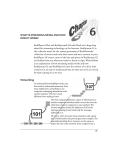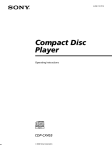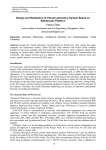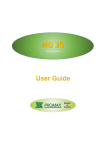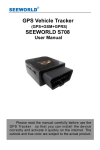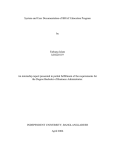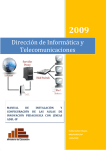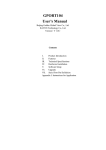Download GLOSSARY - Service & Support
Transcript
GLOSSARY The following pages contain a list of terms defined specifically for RealPlayer. While some of these concepts may have broader meanings and implications, the definitions in this Glossary relate directly to your use of RealPlayer, rather than the world or Internet at large. A Accessory A part of the RealPlayer that is not necessary to its main function, but that enhances your experience during playback (such as the Equalizer). Applet A small application or program with limited ability. Usually this is a helper program or tool such as the Windows Control Panel. Add-in Additions to RealPlayer that may or may not be a part of RealPlayer, but that can be launched from or work with RealPlayer (for example, RealJukebox. Audio Analyzer A tool that analyzes the audio coming into RealPlayer and displays it visually on the Display Panel. B background When a process is set to run in the background there is often no visual cue to alert you that something is happening. During a background process, you can continue to work normally. Bandwidth The amount of data that can be sent to your computer over a short time; usually expressed as kilobits per second (Kbps). The higher the bandwidth, the faster you receive datavery much like using a larger garden hose to get more water faster. Sometimes this refers to a range of sound frequencies and is shortened to band as in the 16-band bargraph Equalizer. In this case, the range of sound that is measurable is broken into equal portions, or bands, of sound to be displayed. Bar A portion of the RealPlayer interface that can be rearranged vertically and is only a single line tall (such as the Clip Info bar). 93 Glossary Bitrate The speed of a connection, how fast information can be passed to your computer over an Internet or network connection. Sometimes known as bandwidth. Bit The single smallest piece of binary information. Byte A unit of digital data usually made up of 8 bits. Often used synonymously for packet when talking about the Internet even though it is not actually the same thing. Packets are usually made up of bytes. (See also packets .) Browser A short term for Internet browser (for example, Netscape, Opera, or Internet Explorer). Buffered Data that is collected but held back rather than made immediately available. Similar to a translator on the news listening to a whole statement before telling you what the speaker has said, rather than trying to give you a less accurate, halting, word-by-word translation. C 94 Cache A temporary storage of frequently used files, kept on your computer. It allows RealPlayer to load a presentation more quickly since those dont not have to be streamed from the Internet each time you play a clip. RealPlayer 8 Plus User Manual Channel Represented by an icon in the My Channels tab, it is a quick link to a service (news, sports, etc.). Channels also update headlines from their associated services on a regular basis when connected to the Internet. Channels tab (My Channels) The portion of the Content Panel that displays Channels. Clip Any media that can play within RealPlayer. Clip Info bar Displays Title, Author, Copyright information about the active clip if any is available. Codec Short for COmpressor / DECompressor. An algorithm used to compress and uncompress data files. Compiled Term describing a file when the raw information, or source-code, has been organized into a usable format for your desktop (for example, RA, DLL, EXE, and COM file-types). Content Panel Opposite the Display Panel. My Channels, Live Stations and My Favorites tabs are displayed on this panel. Control bar The portion of the RealPlayer that contains the controls that act on the active clip (such as Play, Pause, Stop, RealPlayer 8 Plus User Manual Glossary etc.) as well as the position slider, the Equalizer, and any plug-ins or RealPlayer Add-ins (RPAs). D Encode The process of converting media (sound, video, etc.) so it can be streamed to and played by RealPlayer. Datatype Equalizer Determined by the program that creates the media you are viewing and usually distinguished by the extension on the end of the file (for example, AVI, WAV, RM, RMA, etc.). See also Extension. See graphic equalizer. Extension The letters after the period in a filename. For example, .ram would be the extension of thankyou.ram . While often this is related to the data type of the file, this is not always the case. See also Datatype. DirectX A collection of interpreters created by Microsoft that allow sound and video to work faster in Windows95/98 or later and Windows NT 4.0 or later. Display Panel Panel opposite the Content Panel. Used to display visual elements of a clip as well as the Audio Analyzer / Visualizations, and controls for Zoom, Video, Mute, and Volume. Drag and Drop A technique for moving files in a windows environment. Click and hold on a file, then drag it over an application. Release the mouse button to drop the file into the application. E Electronic certificates Electronic certificates are digital fingerprints. Each file carries a special code identifying it as officially sanctioned and approved by RealNetworks to work with your RealPlayer. F Favorites Quick links to reach content on the Internet, similar to the station buttons on a car or home stereo. Filetype A file's type is described at the front of every file and alerts your computer to what programs can use the file. Some programs can use other programs' file-types (for example, word processors can often read other word processor documents). When programs are installed, certain filetypes are associated with that program. When you click on a link or a file, Windows checks to see what program is associated with that filetype and automatically launches that program (for example, doubleclicking on a .ram file should launch RealPlayer and begin to play a clip). File-type is designated by a code in the file header; that portion of the 95 Glossary file that is read first and tells your computer what programs can read it. Often file-type and file extension (for example, .ram) can be used interchangeably, but in actuality, extensions are not always an indication of file-type. RealPlayer 8 Plus User Manual employs a firewall that blocks other protocols. I Internet address of another computer in numeric format (for example, 127.0.0.1). Security devices used to protect companies from unauthorized access to their servers. A firewall ensures that all communication between an organization's network and the Internet conform to the organization's security policies, using either proxy services or packet filtering. Graphic equalizer Divides the sound input into smaller frequency ranges of sound. This lets you adjust each range of sound to fit your preferences rather than just the high or low frequencies, as typical treble and bass buttons do. ISP Internet Service Provider. The service you use to connect to the Internet. Usually this is who you dial up to connect the Internet if you do not have a permanent network connection. L 96 Hyper Text Transport Protocol. A standard language for pushing information across the Internet and a good fall-back to use, though with reduced quality, when your company Sites that stream RealMedia in realtime, including live and pre-recorded media (ex. a radio station with a live announcer playing CDs and Records). Portion of RealPlayer that shows the URL, or Internet address, of the currently playing clip and allows navigation between recently played clips. The double line on the side of any bar that allows you to drag it, changing the top-to-bottom order you see in RealPlayer. HTTP Live Stations Location bar Grab bar H Internet Protocol. Part of the TCP/IP group of information languages (see also TCP/IP). IP address Firewall G IP M Media A general term that includes any visual, audio, or text broadcast. Media Access bar Portion of RealPlayer that offers several ways to quickly find content: RealPlayer 8 Plus User Manual Radio Tuner, Search and real.com Guide. Message bar Portion of RealPlayer that alerts you that you have received a Flash from the Real.com Message Service. Appears at the bottom of your RealPlayer. Mode A specific instance or view of a single tool. For instance, the Bar Graph mode of the Audio Analyzer versus Spectrograph mode. Multicast Used for broadcasting large events over the Internet. Allows many computers to play the same single stream simultaneously. Multi-clip Any sequential string of clips RealPlayer plays from a single file. Multi-instance Multiple RealPlayers running at the same time as when viewing Real.com Take 5 shows. My Channels tab (Channels tab) The portion of the Content Panel that displays Channels. My Favorites The portion of the Content Panel that displays Favorites. P Packet A single package of data sent to a computer. Similar to a single brick in a building. (See also byte .) Glossary Panel Any one of the separate areas of RealPlayer. Each is separated by lines on the top and bottom. Bars may be dragged above and below panels to create a different visual order by using the grab bar. Peak The highest level for a particular sound at a given point in time. Used when viewing the Audio Analyzer. Playlist bar Portion of RealPlayer that displays the name of the current clip within a multi-clip (see multi-clip). Also has the ability to Scan the Playlist. Plug-in A component of the RealPlayer that extends its ability. Synonymous with Add-in. PNM or PNA Progressive Networks Metafile (Audio). The previous standard protocol for streaming media to your RealPlayer. Protocol Language used by computers to talk to each other or to their own components. Components and computers must speak the same language to understand each other. The standard Internet protocol for sending packets of information is TCP/IP (see TCP/IP) while HTTP is the standard for displaying text. In the case of media, the protocol is identifiable at the head of the URL 97 Glossary RealPlayer 8 Plus User Manual (for example: HTTP//, RTSP //, PNM//, etc.). Synonymous with transport . RealMedia Any media that is specifically created to be streamed from RealServers to your computer. Proxy Used in conjunction with a firewall, a proxy or proxy service is a server that initially determines if a requested connection between a computer on the internal network and one on the outside is permitted. If the connection is authorized, the firewall sets up the necessary communication links between the two computers. The firewall can then monitor the communication between the two networks and suppress any unauthorized activity. R RPA RealPlayer Add-in. Authorized thirdparty program additions that give you access to other media or functions. Radio Tuner Portion of Media Access bar that connects to the Web to find the most up-to-date list of radio and TV programming available. Realcom Guide Real.com Take 5 Real.com Take 5 is a special service created by RealNetworks to provide an all-media intenet experience. 98 RTSP Real Time Streaming Protocol. The newest protocol used to stream media to your RealPlayer over the Internet. S Sampling rate How often a sample (measurement) of a audio signal is taken over a specific period of time. Scanning RealPlayer Plus can Scan Favorites so you can find the clips that interest you. The process is similar to using the scan feature of a car radio or stereo. Search Portion of RealPlayer Media Access bar that is used to search for content on the Web similar to a search engine on the Web. Session Each time you start RealPlayer you begin a new session, or round, of using the product. While some information, such as Preferences, are retained from session to session, others, such as which clips have been played, are not. Server Any machine or program that is serving information to another machine or program. RealPlayer 8 Plus User Manual Glossary differently. Most machines will only recognize a single type of transport, though this is not always the case. Synonymous with protocol. Status bar Portion of RealPlayer that displays connection and other information about the current clip. Streaming Media A media file (audio, video, etc.) that is broken into smaller pieces and sent to RealPlayer so it can be viewed or heard immediately rather than forcing the audience to have to wait for the whole file to be downloaded first. T Trough The lowest level for a particular sound at a given point in time. Used when viewing the Audio Analyzer. Tuner see Radio Tuner U Take 5 see Real.com Take 5 TCP Transmission Control Protocol. Part of the TCP/IP group of information languages. More reliable than UDP, but often slower. Transport How data is broken up and sent to your computer over the Internet or your companys intranet or network. Usually used in conjunction with or instead of protocol . Most machines will only recognize a single type of transport, though this is not always the case. User Datagram Protocol. Part of the TCP/IP group of information languages. Similar to, but less reliable than, TCP, though often faster. URL Uniform Resource Locator. This is the complete address that tells your browser and your RealPlayer where to get the information to show or play (for example: www.real.com/thankyou.rm) and how to interpret that information. TCP/IP Transmission Control Protocol/Internet Protocol. Standard protocol used on the Internet to send information back and forth. UDP V Video controls Controls for Contrast, Brightness, Color Level, Tint, and Sharpness for visual presentations. Located next to the Zoom control on the Display Panel. Not all visual presentations support Video controls. They will only be available if the clip supports the controls. Each type of transport is handled 99 Glossary W 100 Web Server A server that makes HTML pages and other content available to your Web Browser. RealPlayer 8 Plus User Manual








![How to open your Preferences Windows Control Panel [Windows only]](http://vs1.manualzilla.com/store/data/005787188_1-657759d9a2a48c6bde523f6baebed157-150x150.png)
